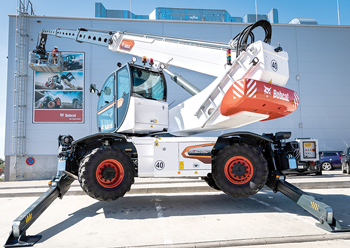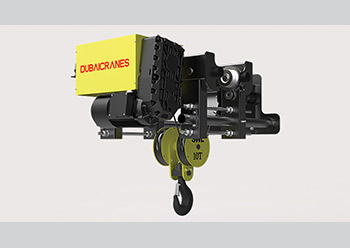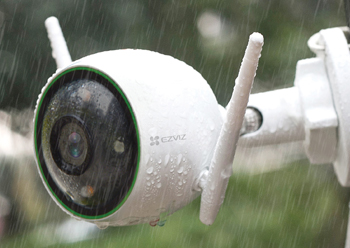
 Bobcat new-generation rotary telehandlers ... enhanced 360-degree performance.
Bobcat new-generation rotary telehandlers ... enhanced 360-degree performance.
Bobcat, a leading construction equipment manufacturer, has collaborated with Magni TH of Italy, to launch an expanded line of new generation rotary telehandlers for the markets in Europe, the Middle East and Africa (EMEA) as well as Russia and the CIS countries.
The new Bobcat rotary telehandler range includes 10 Stage V compliant models for the European market, with lifting heights from 18 to 39 m and lifting capacities from 4 to 7 tonnes.
These are complemented by another four Stage IIIA engine powered models aimed at the Middle East and Africa (MEA) and Russia/CIS regions with lifting heights from 18 to 25 m and lifting capacities from 4 to 6 tonnes.
 |
|
The new telehandlers are offered with a choice of over 20 attachments. |
For both MEA region and Russia/CIS, the Bobcat range comprises the TR40.180, 50.210, 60.210 and TR60.250 models.
Olivier Traccucci, Bobcat Telehandler Senior Product Manager, says: “Our new rotary telehandler range offers an expanded model selection and increased lifting heights and lifting capacities. The new range offers cutting-edge technology that continues the theme of reinvention that is at the core of our ‘Next is Now’ philosophy.
“As a result, they offer enhanced 360-degree performance to create the ultimate tools for even the most complex site handling jobs. A big choice of over 20 attachments and various options also ensures that working at height has never been so versatile, efficient, comfortable and safe.”
The new rotary telehandler range from Bobcat was introduced at an online launch event held in December, which was a continuation of the Next is Now strategy presented for the first time in EMEA and Russia/CIS at a previous online event in October, where Bobcat launched 48 products in 12 different categories.
According to Bobcat, the rotary telehandler market continues to grow worldwide. In Europe, for example, it has increased over the last five years by 23 per cent and, in 2019, it reached over 3,000 units for the first time. Moreover, 85 per cent of the global market volume is in the EMEA region.
These rotary telehandlers are often called three-in-one machines as they combine the attributes of a telehandler with those of an aerial working platform and a crane. Applications are, therefore, mainly in construction (80 per cent) but also in industrial maintenance.
As in all of Bobcat products, operator comfort is a prerequisite in the new rotary telehandlers and the innovative patented design of the cab is key to working safely on site, providing: a fully pressurised environment; 100 per cent air filtration; heating and air-conditioning (except TR40.180); large windows for optimal visibility; ROPS/FOPS certification; an easily adjustable steering column and a comfortable, fully adjustable seat.
In the cab, all Bobcat rotary telehandlers are equipped with a large, bright touchscreen display with intuitive machine controls. Machine settings are managed over five different pages. Navigating between these pages is extremely easy and intuitive using the touchscreen or the jog shuttle.
In Bobcat rotary telehandlers, attachments are almost as important as the machine itself, as they provide the versatility needed on site. The attachments are usually forks (standard), crane jibs, winches or jib winches, man platforms and buckets.
Most of its new rotary telehandlers are equipped with a remote control to operate the machine from the man basket when elevating people as well as operating the machines remotely to enhance visibility and precision at work.
Bobcat says all its rotary telehandlers automatically recognise the attachment they are being paired with using RFID technology, which also uploads the corresponding load charts onto the display. As a result, the machine is ready to work safely within seconds and the touchscreen displays a dynamic load chart which allows the operator to keep an eye on the load’s centre of gravity, it adds.





















_0001.jpg)


.jpg)
















.jpg)








.jpg)






